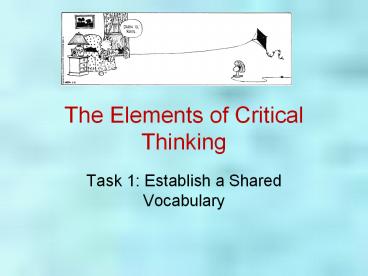The Elements of Critical Thinking PowerPoint PPT Presentation
Title: The Elements of Critical Thinking
1
The Elements of Critical Thinking
- Task 1 Establish a Shared Vocabulary
2
Why does identifying elements help you think
mindfully?
- Makes you really LOOKfights habitual and
enculturated patterns, autopilot thinking - Allows you to identify barriers, filters,
impediments, biases, predispositionsyours AND
others - Gives you more tools to analyze an issue
- Helps you demonstrate fair-mindedness
3
A current example
- What happens when you dont think mindfully?
http//www.youtube.com/watch?vhPpzj4PjNjU - And what happens when you dont think mindfully
about what you just did?
4
WA uses three key terms based on what you DO with
your thinking
- The pitchthe position you are trying to sell
to your audience (often expressed in a THESIS) - The momentthe context, relation of you to
audience, etc. - The complaintwhat impels you to make your pitch
5
Ch. 3 of WA gives you a toolkit to use to
express your thinking process
- Paraphrase x 3makes you clarify and restate so
youre sure youve got it (p. 33) - Notice Focuslets you pick out, prioritize, and
refine ideas (p. 35) - The Methodlets you play with binaries,
oppositions, threads that emerge (p. 37) - Focused freewritinglets you gather ideas on a
slice quickly (p. 44)
6
Nosich focuses not on the writing that comes out
but on the thinking that leads to it
- Purpose p. 52
- Question at Issue (q at i) p. 53
- Assumptions p. 54
- Implications, Consequences, Outcomes p. 55
- Information p. 57
- Concepts p. 58
- Conclusions, Interpretations, Decisions p. 60
- Point of View (p.o.v.) p. 61
- Alternatives p. 64
- Context p. 66
7
Nosichs Circle of Elements
8
Two ways to see the elements (from Richard Paul,
Nosichs teacher)
9
Or, from your point of view
10
Additional Terms You May Use
- Reasons/Reasoningdescribes the process of
thinking - Claims (theses based on your assumptions that you
try to prove) - Arguments (pitches made with theses and support)
- Hypotheses (assumptions based on evidence
testing that you prove or disprove) - Most of these terms are involved with what we
call a deductive or thesis-driven way of
thinkingone that attempts to eliminate
possibilities. Initially, were going to avoid
them.
11
Thinking critically is messy, non-linear, and
recursive
Purpose
Conclusions,Interpretations,Decisions
POV
Assumptions
Information
Alternatives
Concepts
Q at I
Implications,Consequences,Outcomes
Barriers, FiltersBiases,Pre-dispositions
12
Going around the circle
- Can start on any slice
- Gets easier as you repeat it
- Often shows you which areas will be most
productive to work with (not always the ones
where the answers come most easily!) - Generates lots of raw material to draft
fromgives you luxury of selecting the best
13
To master these concepts
- Practice, practice, practice till this starts to
feel comfortable to you. - Try exercises 2.1, 2.2, 2.3 in your thinking
- If theres an element you have trouble with, do
the corresponding exercise at chapters end in
your thinking notebook. - Look at p. 80 as a self-test.
14
What does marriage mean to you?prewriting for
paper 1

